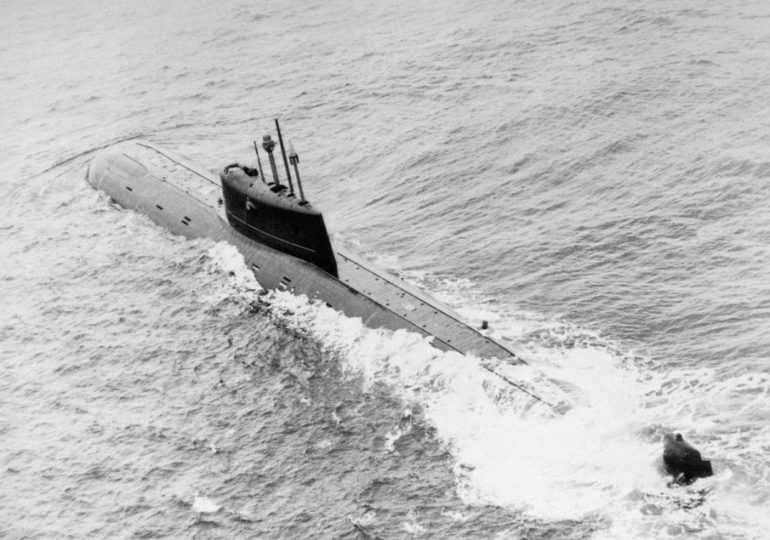A SOVIET nuclear submarine wreck has been emitting toxic levels of radiation that is 100,000 times more than normal.
The Soviet-era sub sunk off the coast of Norway back in 1989, where it has remained – continuing to spew radioactivity for three decades.
WikipediaAn undated picture taken in St. Petersburg showing the nuclear-powered submarine[/caption]
YouTube/@havforskningenThe sub sunk after a fire on board in 1989[/caption]
EPAA photo of the Norwegian Institute of Marine Research using an underwater drone to take samples from Komsomolets[/caption]
YouTube/@havforskningenGusts of dust have been pulsing out of the sub for decades[/caption]
Ill-fated Komsomolets was a ground-breaking invention at the time, with an inner hull made of titanium, revolutionary dive-depths and record-breaking speeds became a possibility for the Soviets.
The sub’s titanium allowed it to withstand 1,500 psi of pressure, which was unheard of in 1984, reach a diving record of 3,350ft, and travel at an impressive speed of 370km per hour.
Yet, it was on its first operational patrol when it met its fiery demise, drowning 42 crewmen, a nuclear reactor and two nuclear-armed Shkval torpedoes.
Russian officials claim to have undertaken several missions to safeguard the reactor from leaking.
However, a Norwegian expedition to the wreckage site found Komsomolets to be leaking radiation which is up to 100,000 times higher than the sea’s normal radiation levels.
Scientists from the Norwegian Institute of Marine Research revealed that they had taken the sample from the area around a ventilation hole which is reported to frequently throw out mysterious gusts of dust.
Scientists added that they believe that the hole is linked to the nuclear reactor, and that the radiation is being periodically pushed out through these gusts.
Hilde Elise Heldal, from the Norweigan Institute, said: “We have observed a kind of cloud coming out of this hole once in a while.
“In connection with the test in which we measured pollution, a cloud came out of the hole. This may indicate that the pollution comes out in pulses.”
Heldal added that her team were able to use an underwater drone to take five samples from the same ventilation hole.
One sample found levels to be normal, another found the radioactive contamination to be 30,000 more than normal, with two showing levels of 100,000 times more than normal.
And one, according to Heldal, was close to being a staggering 1 million times higher than normal levels.
Yet, Komsomolets isn’t the only nuclear sub polluting the area off the Norwegian coast – with thousands of tonnes of nuclear waste plaguing the Kara and Barents Sea.
Experts have warned of a “slo-mo Chernobyl” disaster forming in these icy waters with the nuclear waste being estimated as equivalent to 6.5 Hiroshimas.
Finland’s former Minister of Foreign Trade and European Affairs Jari Vilén said: “It’s a horrible, horrible legacy of the Soviet Union that’s been left at the bottom of the ocean.”
Over 17,000 objects are scattered on the sea bed, with 18 nuclear reactors and sunken nuclear submarines.
Some of the nuclear waste lies at a depth of only 98 ft, putting the Russian produced radiation even closer to humans living in coastal areas.
Experts have warned that these old reactors are full of uranium and say that they will eventually begin leaking mass amounts of radioactive material.
Many are also worried that the more highly concentrated nuclear rods on some submarines may implode underwater, leading to a Hiroshima-esque event.
Thomas Nilsen, the editor of The Barents Observer, told Outrider: “We can’t let those reactors just sit there. We know sooner of later radionuclides will leak out.
“The threat remains of a Chernobyl in slow motion.”
Back in 1992, Tengiz Borisov of the Russian Special Committee for the Conduct of Underwater Work, told reporters that a leak would make fishing in the Norwegian Sea impossible for at least 600 years.
However, Heldal believes that the current contamination results are no reason for alarm.
Heldal explained that the radioactive pollution appears to be quickly diluted, adding that no radiation was found half a metre away from the ventilation hole.
Although Norweigan efforts to monitor the environmental damage of the sub included annual expeditions to the wreckage site between 2019 and 2022, efforts have been halted by the war against Ukraine.
Russia announced a new initiative to rescue the radioactive items from the sea floor, to prevent an “underwater Chernobyl” disaster, but it will take decades.
Finland also began a project involving Norway, Iceland, the EU, US, UK and Russia to safely raise the most dangerous objects back to the surface.
The project is estimated to cost an astounding £241million to hoist up the nuclear items alone.
But the war in Ukraine has stopped the initiative, and Russia left the Russian-Norweigan Nuclear Safety Commission, leaving other countries in the dark about the radioactive waste in their seas.
How did the Komsomolets nuclear submarine sink?
Here’s what you need to know about the fatal submarine accident.
On April 7 1989, a fire broke out in the engine room of the Soviet Komsomolets nuclear-powered submarine
It was at a depth of 335 metres at the time
The fire spread, breaking the nuclear reactor which was powering the submarine and the propulsion was lost
The submarine still managed to make it to the surface and most of the crew abandoned the vessel
42 of the 69 crew members died, most of them due to developing hypothermia as they floated in the cold sea waiting to be saved
YouTube/@havforskningenThe sub sunk with a pair of nuclear torpedoes attached to it[/caption]
YouTube/@havforskningenEerie video footage shows a decaying Soviet flag and date on the nuclear sub[/caption]
YouTube/@havforskningenExperts are becoming increasingly concerned about the graveyard of Russian subs in the Norweigan Sea[/caption]
Leave a comment








